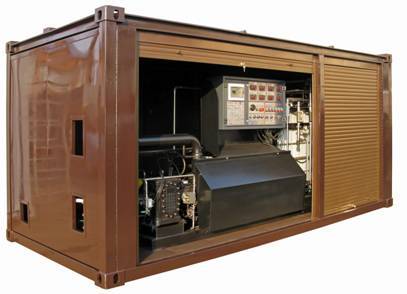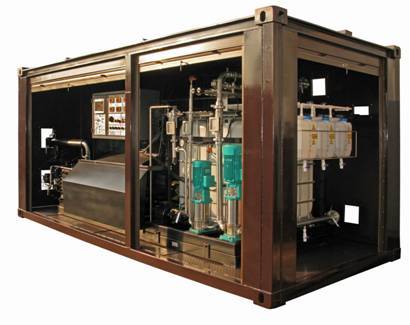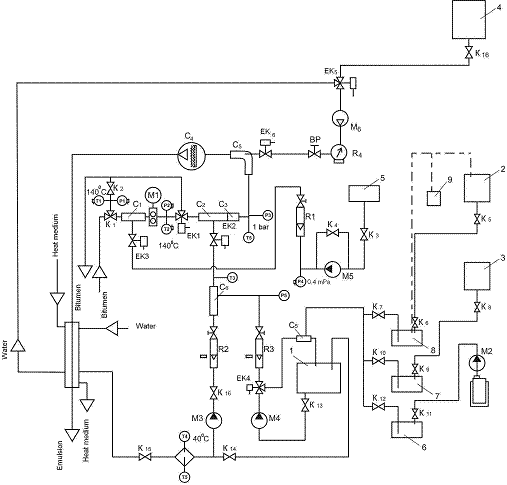Bitumen emulsion plant UVB-1 is designed to produce bituminous emulsions of anionic and cationic type:
- to prepare old road base for asphalt-concrete;
- to prepare cold asphalt-concrete mixtures;
- for surface treatment of roads;
- for making thin protective coatings;
- for patch road repairs;
- to ensure water-tightness of buildings and other constructions;
- for construction and repairing of soft roofs.
Details:
|
1 |
General information |
|
2 |
Technical data |
|
3 |
Technical description of the equipment |
|
4 |
Principle of operation |
|
5 |
Recommended scheme of installation |
|
6 |
Commercial information |
 |
 |
General view of the bitumen emulsion plant
1. GENERAL INFORMATION
Bitumen emulsions are heterogeneous two-phase systems consisting of two immiscible liquids. The bitumen is dispersed throughout the continuous water phase as minute particles typically 0.1-5 µm in diameter, as an oil in water emulsion.
Bitumen-water emulsions must break in a controlled manner upon laying with the mineral aggregate. The efficiency of the breaking process is strongly influenced by the surface characteristics of the aggregate substrate and the properties of the bitumen emulsion. GlobeCore™ Bitumen Emulsion Plants allow to produce bitumen emulsions formulated to obtain optimal emulsion stability and also to provide adequate mixing/breaking rates when mixed with mineral aggregates.
Specialized usage of asphalt emulsion plant
GlobeCore™ Bitumen Emulsion Plants is especially designed to fulfill the requirements of the specialized contractor/producer wishing to produce volumes of emulsion for tack coat and/or pot- hole patching mainly for in-house use. This means that the production capacity as well as the features and level of control of the plant have been purposely chosen to provide an economically feasible production units with the right quality performance for this production situation.
Bitumen emulsion plant production quality
Main components of Bitumen Emulsion Plant are three static mixers and colloid mill especially designed and optimized for bitumen emulsion. Together they produce a fine and narrow particle size distribution, which builds viscosity and improves storage stability. The mill is furnished with frequency control for speed variability. This enables adoption of the emulsion characteristics and improves the quality of emulsion produced with various bitumen types. The complete mill is made in stainless steel with the shaft, the rotor and the stator in an extra high quality alloy.
Easy operation
The complete plant is mounted on one space saving frame laid-out for easy access to control devices and process supervision. The electrical controls are collected in one control panel also mounted on the frame and from this panel the plant is operated.
Operational reliability
Only high quality components and materials are used to ensure best possible operational reliability and a long technical life. The water-phase pipe system like the colloid mill is made in stainless steel to guarantee corrosion resistance.
The plant is laid-out for easy access to all components and electrical wiring. Comprehensive Manuals go with the Plant and include process and electrical schematics, maintenance and service instructions and technical data for the various components and systems.
Fast and straightforward installation
The Plant is fully assembled with all equipment mounted on one space saving frame. The plant is tested and calibrated at factory before delivery. The local commissioning takes normally less than three working days provided other equipment; tanks, etc are installed.
2. TECHNICAL DATA
|
№ |
Parameters |
Values |
|
1 |
Capacity, t/h |
8 |
|
2 |
Water consumption, m³/h |
5…7 |
|
3 |
Additives consumption, l/h |
50…350 |
|
4 |
Bitumen consumption, m³ /h |
10,5 |
|
5 |
Acid consumption, l/h |
50…150 |
|
6 |
Emulsifier consumption, l/h |
50 |
|
7 |
Bitumen input pressure, MPa |
0,2 |
|
8 |
Bitumen mixer pressure, MPa |
1,4 |
|
9 |
Liquid mixer pressure, MPa |
0,2 |
|
10 |
Bitumen input temperature, ºC |
140…160 |
|
11 |
Water input temperature, ºC |
40…60 |
|
12 |
Emulsion maximum raise height, m |
10 |
|
13 |
Power consumption, kW |
46,6 |
|
14 |
Voltage, ~50 Hz, three phases |
380 |
|
15 |
Dimensions, mm: length: width: height: |
6100 4270 2810 |
|
16 |
Weight, kg |
4355 |
2. TECHNICAL DESCRIPTION OF THE EQUIPMENT.
Bitumen emulsion plant UVB-1 is designed to produce bituminous emulsions of anionic and cationic type:
- to prepare old road base for asphalt-concrete;
- to prepare cold asphalt-concrete mixtures;
- for surface treatment of roads;
- for making thin protective coatings;
- for patch road repairs;
- to ensure water-tightness of buildings and other constructions;
- for construction and repairing of soft roofs.
Asphalt Emulsion block consists:
- 1 – Bitumen pump type DC-180
- Type – gear pump, capacity – 500 L/min, working pressure – 0,59 MPa (kg/cm²),max. bitumen temperature -180°C, max safe revolutions rate – 480 rpm, weight – 320 kg
- 2 – Colloid mill GlobeCore®
- Viscosity – 400 – 1.500mPa s (cP), Design pressure-8 bar, design temperature-200°C, operating suction pressure – 0.3 bar minimum, operating pressure expected – 1,5 to 2,5 bar, operating temperature, expected – 95 to 180 °C, seal flushing liquid – water.
- 3 – Hydrodynamic mixer
- Three-stage mixers with valves and piping.
- 4 – Additives mixer
- 5- Bitumen pump drive
- Three-phase asynchronous motor 5A 160 M4 (power 18,5 kW, 1500 rpm)
- 6 – Gear box
- Reducer 1MC-160-10
- 7- Mill drive
- Three-phase asynchronous motor, power 18 kW, 3000 rpm
- 8 – Temperature and pressure sensors
- Temperature transducer type TCP-1-5-Pt-100, temperature range – 0…+250 °C,
- Pressure transmitter type A-10, pressure ranges – -1 …24 bar, signal outputs – 4…20 ma
- 9 – Pneumatic valve
- Pilot pressure – 6 – 8 bar
- 10 – Bitumen T-valve
- Three-way bitumen valve with heating jacket, type – K-80-S-00-01, Ø80
- 12- Frame
- Mounting frame consists of steel profiles and serves for safe mounting and piping of all machines and devices.
- Material: construction steel St 37-2
Water phase block consists:
- Flow metersFlow meters FloTrak Metal VA, accuracy – ± 2% FSD, repeatability – 0.5% of flow, materials – 316 SS standardMeasurement range, m³/h – 1st Flow meter: to 10 m³/h2nd Flow meter: to 4 m³/h3rd Flow meter: to 0,5 m³/h
- Solvent (kerosene) pumpGear pump NS-14 (three-phase asynchronous motor ,0,75 kW, 1350 rpm),capacity – 22 L/min
- Water phase pumpWILO MVI 207 -Vertical High Pressure Centrifugal Pump with three-phase (1.1 kW)
- Water pumpWILO MVI 807 – Vertical High Pressure Centrifugal Pump with three-phase (3.0 kW)
- Water phase mixerstainless steel AISI 316Ti
- Emulsifier and additives dosing tanks
- Water dosing system
- water conducting pipeline – stainless steel AISI 316Ti
- Water phase tank
Bitumen emulsion plant Control panel

In steel enclosure, panel, waterproof. Containing all electrical apparatuses, contactors, thermo-relays, fuses, press buttons and main switch.
Technological parameters of the bitumen emulsion production process are programmed and controlled by controller LOGIC ZELIO Schneider Electric.
Control and measuring device 2ТРМ1 – Pressure of bitumen after pump
Control and measuring deviceТРМ1 – Bitumen temperature after pump
Control and measuring deviceТРМ1 – Bitumen temperature before pump
Control and measuring deviceТРМ1 – Bitumen pressure before pump
Control and measuring deviceТРМ1 – Water blend temperature
Control and measuring deviceТРМ1 – Water temperature
Control and measuring deviceТРМ1 – Temperature of emulsion before mill
Control and measuring deviceТРМ1- Pressure of emulsion before mill
4. Asphalt bitumen emulsion plant principle of operation
Hot bitumen is pimped through tree way valve to mixer C1 (see the flow diagram below) and partially through valve K2 back to bitumen tank. Additive is pumped to mixer C1 by pump M5 from tank 5 through flowmeter R1 and valve EK3. Mixture of bitumen and additive under high pressure is pumped by pump M1 through valve EK1 to injection mixer C2, where it is blended with water phase. Mixture of water and bitumen enters the third hydrodynamic mixer C3, where bitumen droplets are split into smaller particles. Emulsion than stabilized in the colloid mill C4 and cools down in the water/emulsion heat exchanger on it’s way to emulsion tank.
Water phase block is a double circuit mixer. First circuit consist of water tank, pump M4 and injection mixer C5. The second circuit – mixer C6, where water is mixed with additives, fed into injection mixer by pumps M4 and M3. Water phase is prepared in the tank 1, which is filled with warm water from water reservoir. Water circulates through water tank 1 and mixer C5 where low pressure is created by pump M4. Acid, emulsifier and additives introduced into water tank through valves K7, K10and K12 from dosing tanks 6,7 and 8. Water phase pH level is checked by pH-meter and corrected if required. During plant operation water phase is prepared simultaneously with emulsion preparation in the mixer C6. pH level of water phase is maintained in the range between 2 and 2.5. Water is dosed byM3 pump and water phase – by pump M4. Water and water phase flows are controlled by flow metersR2 and R3.
Water is heated to desired temperature in the water tank and in the heat exchanger 10. Emulsifier is heated in the heater and pumped with the pump M2 to dosing tank 6. Acid neutralizer 9 is used to neutralize acid vapors. Water and polymer (Butanol) mixture is pumped with the pump M6 through flow meter R4, valve K16 and three way valve K15 to emulsion preparation block. Pumps, flow meters and pipes are flushed with clean water at the end of the process.

